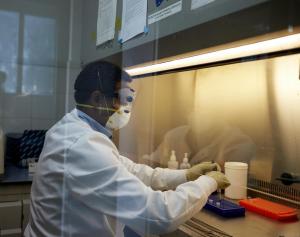Genome sequencing in Ebola response
Conakry – Studies show that the Ebola virus can persist in bodily fluids – such as semen and breast milk – of survivors for months. The recent resurgence of Ebola in Guinea and the Democratic Republic of the Congo has been linked to bodily fluids of survivors. Dr Magassouba N’Faly of the Gamal Abdel Nasser University in Conakry and the Haemorrhagic Fevers Laboratory at the Guinea Virology Research Centre explains the importance of genome sequencing in determining the source of Ebola outbreaks.
Why was it important to perform genome sequencing after the current outbreak was declared?
One of the objectives of our virology laboratory is epidemiological support, or molecular epidemiology. In short, this allows epidemiologists to identify the source of infection and the viruses’ mode of transmission. Sequencing plays a major role in this process because it identifies the genetic structure of the virus. It also allows for a portion of the virus genome to be compared with those of other known strains.
The sequencing results revealed two key findings. First, this virus was the same virus responsible for the deadly 2014–2016 epidemic. Secondly, the virus is not from an animal source but was transmitted from one human to another. These results allow policymakers and scientists to implement appropriate public health measures to avoid a similar resurgence and to undertake research that could answer the multiple questions raised by this discovery.
The virus in the ongoing outbreak is not from an animal source. What questions does that raise?
If the virus can remain latent for such a long period of time, it raises many questions given the large number of survivors in the three countries affected by the previous epidemic (Guinea, Liberia and Sierra Leone). We will need to determine what type of threat this virus dormancy poses and be prepared to deal with the possible stigmatization of survivors. In addition, we must consider how such latency in the body can be detected. This also raises the question of what public health measures to put in place. Finally, we will need to determine whether vaccination is a solution or whether treatment is a more effective option. In the case of the latter, it will be necessary to determine which molecule to choose.
Should we fear a silent Ebola spread as the virus can survive for long in the human body?
I would say it is more a latency, and not a spread. It is certain that there is a dormancy in a target organ with limited antibodies where, with the combination of certain factors still not well understood, the virus could undergo a revival (a return to active living forms) and cause a secondary viremia (presence of a virus in the blood) which could be the origin of human-to-human transmission of the virus. There is also the possibility that the virus could be secreted in small amounts from a survivor and transmitted to a health worker during childbirth or surgery.
What should be done better or differently in terms of monitoring Ebola survivors?
We will need to establish a long-term programme that includes regular identification of the virologic and immunological status of survivors. We need to continue to vaccinate people close to survivors if they are immunocompromised. And we will also need to manage the after-effects of the virus and establish a system for reporting illnesses with fevers of an unknown aetiology, that is, those resistant to antimalarial, antibiotics as well as deaths around survivors.
Chargé de la communication et de la promotion de la santé
OMS Guinée
Email : konatei [at] who.int (konatei[at]who[dot]int)
WHO Regional Office for Africa
Acting Regional Communications Manager
Email: ottob [at] who.int (ottob[at]who[dot]int)



